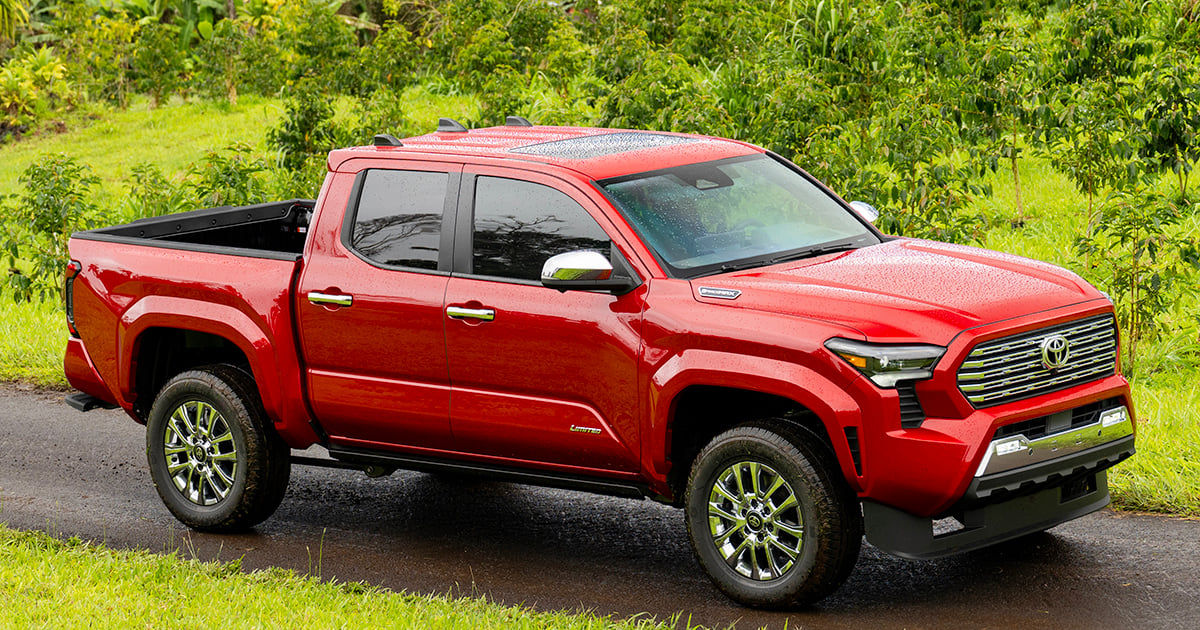
WAIMEA, Hawaii — With the possible exception of the RAV4 compact crossover, no nameplate in Toyota‘s U.S. lineup is more important to the brand than the Tacoma midsize pickup — not just because of its sales, but also the way it continues to dominate the competition, albeit with less of a stranglehold than before.
With the redesigned 2024 Toyota Tacoma arriving at U.S. dealerships this year, the Japanese brand looks to brush back newly improved offerings from Detroit 3 rivals and reinforce its formerly vicelike hold on the important segment.
The Tacoma’s segment share in the U.S. peaked in 2013 at a massive 65.1 percent as other automakers exited midsize pickups in favor of more profitable full-size pickups. However, their return a few years later began to bite into Toyota’s dominance: By 2018, the Tacoma’s share of the segment had fallen to 46.9 percent, and in 2022, it dropped to 39 percent, according to the Automotive News Research & Data Center.
Toyota unwrapped the latest Tacoma for the media here late Thursday.
“Our dealers have been very involved” in the development of the redesigned Tacoma, said Dave Christ, who heads the Toyota Division of Toyota Motor North America. “We included them in the process of developing and engineering the truck, and we think we hit on all of the asks for the segment.”
Christ said he anticipates a huge reception for the latest Tacoma, especially given the brand’s experience launching the redesigned Tundra two years ago.
“It’s pretty powerful. The dealers are fired up. When you look at the old-generation Tundra versus the new one, it was an enormous leap forward, and it’s going to be the same feeling for the dealers with the Tacoma,” Christ said. “The [current] Tacoma has aged well, it’s still selling very well, but this new one is just badass.”
Danny Wilson, immediate past president of the Toyota National Dealer Advisory Council and a current member of the council’s product committee, said the Tacoma remains a foundation stone for the brand.
“On the West Coast, especially, it’s iconic. There are very few Toyota people who don’t have either a Tacoma or a Camry story to tell,” said Wilson, dealer principal at Wilson Toyota of Ames in Iowa. The Tacoma, he says, “has become a staple for all of us, too. When you own that much of a market, it becomes a drawing point for the brand across the board.”
As the third of four body-on-frame U.S. vehicles to move onto the Japanese automaker’s new F1 platform, the retooled Tacoma represents an opportunity for Toyota to scale both the advancements and the lessons learned from the launches of the redesigned Tundra full-size pickup and Sequoia large SUV. The redesigned 4Runner midsize SUV will complete the circuit for what Toyota calls its Four Brothers next year.
As with the Tundra and Sequoia, the biggest change in the redesign is a downsizing of the Tacoma’s powertrain and improvements to the suspension.
Gone is the current generation’s V-6 engine in favor of a standard turbocharged 2.4-liter four-cylinder engine, producing up to 278 hp and 317 pound-feet of torque. An optional hybridized version delivers a combined 326 hp and 465 pound-feet of torque. Most versions of the Tacoma will come standard with an eight-speed automatic transmission, while a six-speed manual transmission will be available on the base SR trim.
The Tacoma will also have an available multilink rear suspension on some trim levels, replacing the current version’s leaf springs, though those springs will remain standard equipment on the SR, SR5 XtraCab and TRD PreRunner trims. Four-wheel disc brakes are now standard equipment, as is an electronic parking brake and electric power steering, Toyota says.
Inside the cabin, screens dominate the instrument panel. The Tacoma will receive Toyota’s voice-activated Audio Multimedia System, which debuted on the Tundra. It will reside on either the standard 8-inch or available 14-inch center-mounted touchscreen. A 7-inch gauge instrument cluster is standard on lower trim levels, while higher-end trims get a 12.3-inch configurable digital gauge cluster.
Storage is also improved, Toyota says, with enhanced storage under the rear seat on nonhybrid models and with a flat-folding rear seat back to make it easier to transport larger items in the cabin.
There are eight trim levels across the lineup, starting with the base SR, SR5 and Limited trims. There are four TRD trims — PreRunner, Sport, Off-Road and Pro — each configured with a different primary use case in mind, while a new Trailhunter trim offers an off-roading rig that’s factory-equipped with traditional aftermarket accessories from ARB, Old Man Emu and Rigid, Toyota says.
All Tacomas will come standard with Toyota Safety Sense 3.0, the latest version of the automaker’s suite of driver-assistance and safety technology, including dynamic cruise control, lane-departure and lane-tracing assistance, and proactive driving assist, which helps keep the vehicle in control under certain conditions.
Pricing and fuel economy ratings will be revealed before the nonhybrid versions of the redesigned Tacoma go on sale late this year, Toyota said. Hybrid versions are expected to begin shipping to dealerships early in 2024.